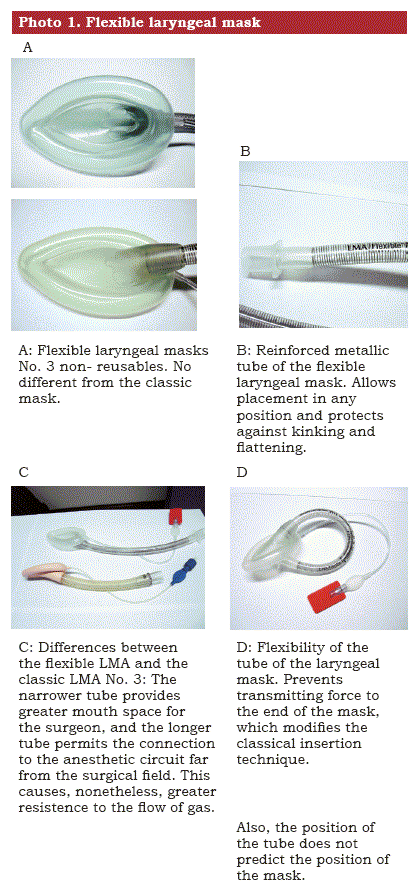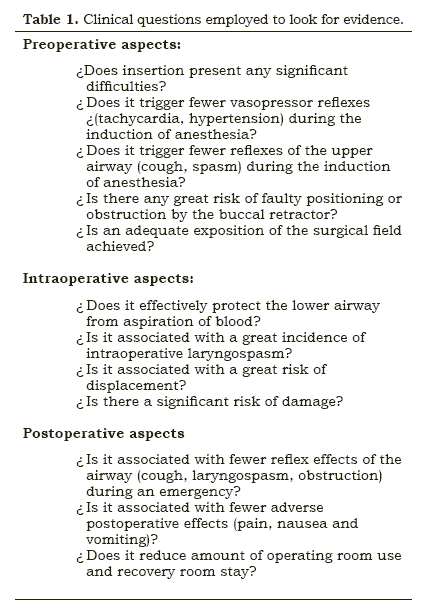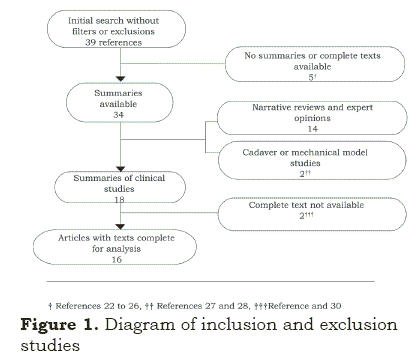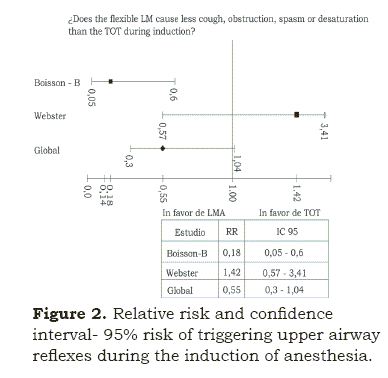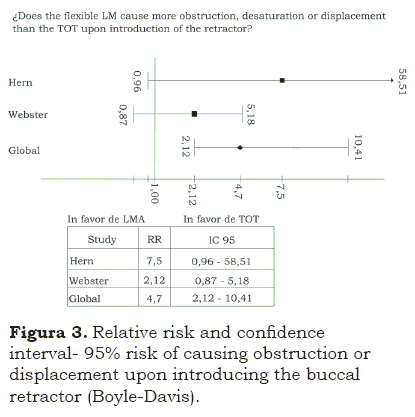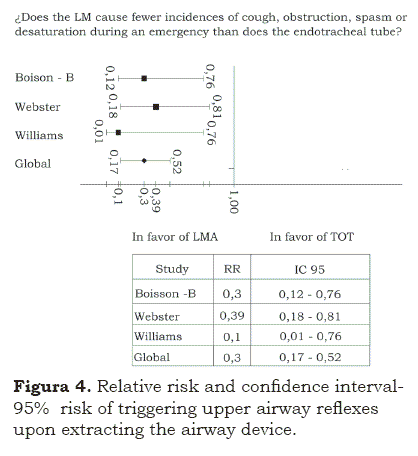Services on Demand
Journal
Article
Indicators
-
 Cited by SciELO
Cited by SciELO -
 Access statistics
Access statistics
Related links
-
 Cited by Google
Cited by Google -
 Similars in
SciELO
Similars in
SciELO -
 Similars in Google
Similars in Google
Share
Colombian Journal of Anestesiology
Print version ISSN 0120-3347
Rev. colomb. anestesiol. vol.37 no.4 Bogotá Oct./Dec. 2009
REVIEW ARTICLES
Security and effectiveness of the laryngeal mask airway in the tonsillectomy and adenoidectomy: A systematic review of literature
Seguridad y efectividad de la máscara laríngea en amigdalectomía y adenoidectomía: una revisión sistemática de la literatura
Luz María Gómez1*, Gustavo Reyes Duque**, Federico Ocampo***, Juan Camilo Gómez****, Fernando Echeverri****
1 Primer puesto Concurso Juan Marín – XXVIII Congreso Colombiano de Anestesiología. Camino a la excelencia, marzo 2009, Bogotá.
1 First Prize, Juan Marin Competition, XXVIII Colombian Congress of Anesthesiology, March 2009, Bogota, Colombia.
* MD. Especialista y docente de anestesiología. Universidad de Caldas. Especialista en docencia universitaria. Universidad Católica.
Manizales, Colombia. E-mail: lagomezco@yahoo.com
** MD. Especialista y docente de anestesiología. Universidad de Caldas. Especialista en docencia universitaria. Universidad Católica de
Manizales, Colombia.
*** MD. Especialista en anestesiología. Universidad de Caldas. Anestesiólogo Hospital Infantil de la Cruz Roja. Manizales, Colombia.
**** MD. Estudiante de tercer año del postgrado en anestesiología. Universidad de Caldas. Manizales, Colombia.
Recibido: Abril 11/2009 Aceptado Diciembre 11 de 2009
SUMMARY
Background: The laryngeal mask airway is a medical device that must be used with precise indications and contraindications. Its use in tonsillectomies and adenoidectomies has been reported to generate controversy. Through the present study an attempt is made to evaluate the effectiveness and the security of the laryngeal mask airway in tonsillectomies and adenoidectomies. Methods: A systematic review. Results: 16 studies were obtained as a result of the systematic search of the published evidence. They were analyzed with methodological rigor and the following results were obtained: The flexible laryngeal mask airway brings about fewer respiratory adverse effects during the induction and the emergence of anesthesia than the endotracheal tube. It is effective in preventing sanguineous bronchoaspiration during surgery. Furthermore, it must be used by trained personnel and in collaboration with the surgeon to avoid adverse events like displacement, obstruction or occupation of the operating field. Conclusions: the flexible laryngeal mask airway is a useful and safe alternative for the handling of the airways in tonsillectomies and adenoidectomies by its advantages in the induction and emergence of surgery since it triggers less protective reflections of the airway at the moment. In order to avoid intraoperating complications one must have experience in its use plus empathy must exist between the surgical team and the anesthesiologist.
Key words. laryngeal mask, airway, flexible, tonsillectomy, adenoidectomy, review, systematic. (Source: MeSH,NLM)
RESUMEN
Introducción: la máscara laríngea es un dispositivo médico que debe emplearse con indicaciones y contraindicaciones precisas. Su uso en amigdalectomía y adenoidectomía ha sido reportado en la literatura generando controversias en el medio. Con el presente estudio se pretende evaluar su efectividad y su seguridad en las cirugías de amigdalectomía y adenoidectomía. Metodología: revisión sistemática de la literatura. Resultados: como resultado de la búsqueda sistemática de la evidencia publicada se obtuvieron 16 estudios que se analizaron con rigor metodológico obteniendo los siguientes resultados: la máscara laríngea flexible provoca menos efectos adversos respiratorios durante la inducción y la emergencia de anestesia que el tubo endotraqueal; es efectiva en prevenir la bronco-aspiración sanguínea intraoperatoria; debe ser utilizada por personal entrenado y en colaboración con el cirujano, para evitar eventos adversos como el desplazamiento, la obstrucción o la ocupación del campo operatorio. Conclusión: la máscara laríngea flexible es una alternativa útil y segura para el manejo de la vía aérea en cirugías de amigdalectomía y adenoidectomía por sus ventajas en la inducción y emergencia de la cirugía, ya que desencadena menos reflejos protectores de vía aérea en estos momentos. Para evitar complicaciones intraoperatorias debe haber experiencia en su uso y empatía entre el grupo quirúrgico y anestesiológico.
Palabras clave: máscaras laríngeas, tonsilectomia, adenoidectomía, amigdalectomía. (Fuente: DeCS, BIREME)
INTRODUCTION
Since its first appearance, the laryngeal mask has become a tool of widespread use in anesthesiology. Reports exist concerning its use in practically every type of surgery, which, obviously, generates controversy (1). One disputed point is its employment in tonsillectomies and adenoidectomies. The implementing pioneers in these kinds of surgeries utilized the classic laryngeal mask, but quickly abandoned such use due to complications (kinks and obstructions) that led to the development of the flexible or reinforced laryngeal mask (2-6) (see photograph 1). From that time until today, in some institutions this is the preferred device for tosillectomy and adenoidectomy surgeries (7). The opinion expressed in anesthesiology textbooks (8,9), in otolaryngology textbooks, and in recent articles (11,12) is that the flexible laryngeal mask airway is a safe and effective option. Nevertheless, the reality is that its use is not very popular among anesthesiologists who routinely perform tonsillectomies (13). In Colombia its use has been almost nil (14). A survey, taken by a research group, of 100 of the country’s anesthesiologists found that fewer than 10% of them have employed the mask at some time during these surgeries, and even less as concerns the flexible mask. In general, the opinion among those surveyed is that the laryngeal mask airway is not reliable during these surgeries (see Annex 1).
There exists a discrepancy between the recommendations expressed in literature and in clinical practice. When these situations occur jointly, systematic revisions of literature become one of the best scientific instruments allowing the clinician to make decisions (15). As such, the general objective, through carrying out a systematic revision of literature, being sought in the following work is the evaluation of the safety and effectiveness of the laryngeal mask during tonsillectomies and adenoidectomies.
1. METHODOLOGY
The University of Caldas Group of Anesthesia and Education, composed of graduate students and anesthesiology professors, carried out the research process in accordance with internationally accepted recommendations (16, 17).
1.1. Composition of clinical questions
In order to carry out the search a series of clinical questions was composed that included the following four components: population, intervention, comparison, and results. For all of the questions the headings, corresponding to the population under study, read: “In patients undergoing tonsillectomies or adenoidectomies; in intervention, “The use of the laryngeal mask”, and for comparison “Endotracheal tube” was used. The questions can be seen in Table 1.
1.2. Inclusion and exclusion criteria
The search for literature included original, integrative studies (systematic revisions and meta- analysis), first-rate original articles (those of observation or clinical trials) and narrative studies which included editorials or letters to the editor taken as the opinions of experts. The intervention that was evaluated was the intraoperational use of the laryngeal mask during the adenotonsillectomy and the relevance of the studies was found in the reporting of some of the following points: safety, effectiveness, and complications. No discrimination was applied concerning gender, age of population or language of publication.
Studies involving animals, cadavers, mechanical models and publications prior to 1988 were excluded.
1.3. Search strategy
The identification of studies occurred through searches in the databases of Medline (http://www.pubmed.gov), Embase (www.embase.com), Lilacs (www.bireme.br/bvs/I/ibd.htm) and Cochrane Controlled Trials Register (www.cochranelibrary.com/enter/).
The search was carried out using the following terms: Mesh and No Mesh and the Boolean connectors AND, OR: Anesthesia-Airway-Tonsillectomy- Adenoidectomy-Adenotonsillectomy- Laryngeal mask airway-Endotracheal tube- Flexible laryngeal mask airway-Armored laryngeal mask airway-Reinforced laryngeal mask airway-Complications-Safety-Effectivenesslaryngospasm- Obstruction-Technique-Hemorrhage- Haemorrhage-Aspiration-Postoperative pain-Vomiting.
When the attainment of articles on the Internet was not possible, authors’ texts were requested personally by electronic mail.
1.4. Revision methodology
The researchers independently carried out the literature search and included the complete texts of all the articles available. Concerning the articles included for analyses, a form was filled out which included the following items: source, year of publileanos cation, authors, locale, research problem, outlined objective, research methodology (type of study), measured variables, results and conclusions. Afterward, in a meeting of the research group, the technical and statistical data of each study were completed with an analysis in accordance with the precepts of Evidence-Based Medicine (18). As a result of this meeting, each article analyzed was assigned an evidence level based on the guidelines of the AHA (19).
1.5. Statistical analysis
With the data obtained from the complete texts of prospective studies, aleatory and controled and whose populations and designs were homogeneous, 2X2 tables were constructed on which were calculated the value of p with the Mantel-Haenszel correction; and for the tables whose values were less than 5, the value of p with the Fisher test, employing the Epi-Info software (20). For the calculation of relative risk with the respective confidence interval of 95%, the funnel graphics and homogeneity test (Q), the software Review Manager was used (21).
2. RESULTS
2.1. Systematic revision of the literature and analysis
As a result of the systematic search 39 relevant bibliographical references were found. The discrimination employed in order to determine the final articles to be used in analysis is summarized in Figure 1. The main characteristics of the 14 studies analyzed are summarized in Table 2.
2.2. Answers for the clinical questions posed
2.2.1. Any major difficulties concerning insertion?
Yes. Three of the four clinical trials posed major difficulties when compared with the endotracheal intubation technique with a p < 0.001. The series of cases reports the incident as between 13 (38) and 1.2% of the patients (40).
2.2.2. Are fewer vasopressor reflexes triggered during induction?
The insertion of the flexible laryngeal mask airway to an adequate level of anesthetic depth causes fewer hemodynamic effects than the insertion of the endotracheal tube with a significant statistical difference (p<0,001) (31-33).
2.2.3. Does it trigger fewer reflexes of the upper airway during induction?
The effects of cough, laryngospasm, and bronchospasm or saturation are less frequent in comparison with the endotracheal tube (see Figure 2).
2.2.4. Is there greater risk of malposition or obstruction by the buccal retractor?
Yes. In contrast to the endotracheal tube, the placing of the Boyle-Davis buccal retractor causes more frequent displacement and malpositioning of the laryngeal mask (see Figure 3).
This incidence is reported as between 1.2 (40) and 4% (42) of the series of patients.
2.2.5. Is an adequate exposition of the surgical field achieved?
In three clinical trials (31-34), which brought together a total of 289 patients (141 in the laryngeal mask groups and 148 in the endotracheal tube groups), in no case was the endotracheal tube used. The surgeon received no complaints in the surgical field while he did receive complaints in the four cases in which the laryngeal mask airway was used. The difference between the groups has a value of p=0.055.
2.2.6. Is the lower airway effectively protected against aspiration of blood during the intraoperative phase?
Yes. Through intraoperative bronchoscopy and visual inspection of the laryngeal mask airway upon finalizing surgery, in three clinical trials (31-33) no trace of blood was found in the upper airway; in contrast, whenever endotracheal tubes were employed, upon inspection of these at the moment of extracting them the presence of blood on the walls was evidenced. The comparison between the two groups demonstrated a value of p<0.001.
A suspicious incident concerning bronchoaspiration with the use of the laryngeal mask airway is described but uncomfirmed in the postoperatory phase (40).
2.2.7. Is it associated with a greater incidence of laryngospasm in the intraoperative phase?
Of the total number of patients, including those in the clinical trials (31-32-34), laryngospasm occurred in three patients of the 148 comprising the group with laryngeal masks airways versus none of the patients of the 154 in the endotracheal tube group. The difference, nonetheless, was not of statistical significance (p=0.109).
In two series of 20 cases, each series consisting of 20 patients (38-39), “intraoperative obstruction” was reported in 19 and 30% of the cases with no explanation for the etiology.
2.2.8. Is there an increased risk of intraoperative damage?
There are three cases published that demonstrate the risk of damage to the device with the surgical instruments (7-44-45).
2.2.9. Is it associated with fewer airway reflex effects during the postoperative phase?
The use of the flexible laryngeal mask airway reduces the incidence of cough, laryngospasm, bronchospasm or obstruction in the case of emergency surgery (see Figure 4).
2.2.10. Is it associated with less pain, nausea or postoperative vomiting?
Not likely. Confirmation of the hypothesis that the use of the laryngeal mask airway reduces nausea or vomiting induced by morphine (37) was not achieved and no clinical trial has been designed to evaluate the impact of its use in postoperative pain.
2.2.11. Does it reduce the amount of time the operating room and recovery room are in use?
It likely does. A retrospective study (35) demonstrates a significant reduction in the time patients spend in the recovery room. No study to date has evaluated the length of the surgery.
3. DISCUSSION
3.1. Aspects of the preoperative stage
As can be expected, by being an “extraglottic” device, the flexible laryngeal mask airway causes fewer adverse hemodynamic effects (hypertension and tachycardia) than the insertion of the endotracheal tube during the induction of anesthesia. This assertion may not be important in the majority of patients who undergo tonsillectomies or adenoidectomies (usually ASA I children), but it is indeed an important factor for that minority of patients with cardiopulmonary disease.
Concerning the situation that its insertion causes less activation of the protective reflexes of the airway during induction, there are no doubts as to the advantages: in children, tonsillectomy and adenoidectomy surgeries are by themselves a risk factor for the development of laryngospasm (46). That is why all steps that are taken to prevent its onset should be considered.
The high proportion of displacement and obstruction found upon fitting the buccal retractor (see Figure 3) can be expressed as an important adverse factor of the laryngeal mask airway. It is worth analyzing the results of the study that rerecuperación ported the highest incidence of obstruction during induction (32): the obstruction cases occurred in the first patients under study when the research personnel had not yet acquired enough experience in its use.
Once the appropriate skill to manage it correctly had been acquired, this complication disappeared. Acquiring the skills in the use of the flexible laryngeal mask airway in non-otolaryngological surgeries before using it in these types of procedures, is a recommendation of the experts in the field (2). Statistical analysis makes it clear, besides, that the operative field is appropriate for the surgeon when the mask has been positioned well. The only clinical trial that reports the contrary (34), although it was taken into account in the analysis, evidenced important methodological errors such as the lack of “ciego” [insight?] on the part of the surgeon, the lack of a clear definition of the complications, and a probable bias on the part of the operator (47).
3.2. Intraoperative aspects
Three important situations to be analyzed exist: the first is that the flexible laryngeal mask airway appropriately protects the upper airway from aspiration of blood during surgery, and the contrary is simply not true. The flexible laryngeal mask airway is as useful as the endotracheal tube with the ball, and superior to the endotracheal tube without the ball as concerns the prevention of intraoperative blood aspiration during the tonsillectomy or adenoidectomy. Prior to the analysis of the clinical trials, studies with the prototype flexible laryngeal mask airway in healthy, anesthetized volunteers demonstrated an adequate seal of the upper airway by the mask (48-49).
The second point involves the risk of intraoperative laryngospasm. In the analyzed clinical trials this complication was experienced more frequently in patients who had been intervened with laryngeal mask airways instead of those with the endotracheal tubes, but it was not demonstrated that the differences were significant statistically.
Although disputed in light of a recent article that reports the laryngeal mask airway as a risk factor per se (50), it is true that the laryngospasm is a complex phenomenon in which most likely an inadequate anesthetic depth is one of the triggering factors more important than the airway device now being employed (47).
Lastly, concerning the possibility of damage to the device on the part of the surgeon, it is obvious that in order to use the flexible laryngeal mask airway, collaboration should exist between the surgeon and the anesthesiologist.
3.3. Postoperative aspects
One of the advantages of using the flexible laryngeal mask airway in tonsillectomies and adenoidectomies is that upon terminating the surgery the extraction of the device is possible while the patient is awake and when she or he is capable of protecting the airway without triggering life-threatening airway reflexes or reflexes that endanger the final results of the surgery. The findings of the meta-analysis demonstrate its overwhelming role as protector in the event of cough, laryngospasm, obstruction or desaturation during the postoperative stage (see Figure 4).
The question that arises now is the following: How necessary is it to routinely de-tube tonsillectomy and adenoidectomy patients while they are awake? The opinion of some experts is to practice it in all the patients (8), while others opine that this decision stems from the clinical judgment of each patient, being actually necessary only in patients with obstructive sleep apnea (10). It is not the objective of the present study to evaluate the effectiveness of one or the other.
Concerning the effectiveness or lack of effectiveness in using the laryngeal mask airway in the reduction of other postoperative events (pain, nausea, vomiting) and in reducing the hospital stay in tonsillectomy and adenoidectomy surgeries, studies designed for this specific purpose are needed.
3.4. Limitations of the study
This is the first systematic review that has been carried out on this topic. Although publications exist that support this affirmation (51), they deal with a narrative review without the rigor of systematic revision and without carrying out stastistical analyses.
The main weakness of the present study is the lack of some important articles to help with analyzing the information, specifically two clinical trials whose complete texts were not accessible (29-30). Nonetheless, the reading of the summaries of these articles does not show any differences in the results obtained. Later, probably, the information extracted from them will confirm the findings of the present analysis. Concerning the five articles for which the summaries or complete texts were not available (22-26), we cannot infer anything.
CONCLUSIONS
The authors of the current paper conclude that the flexible laryngeal mask airway is a safe and effective option for tonsillectomies and adenoidectomies. Its advantages can be appreciated mainly during the induction and the patient’s emergence from the anesthesia since it allows a superficial plan of de-tubing without triggering adverse reflexes in the patient. In order to overcome possible intraoperative adverse events (displacement, obstruction of the operating field, damage of the mask and laryngospasm) one should be trained in its use, enjoy the active collaboration of the surgeon as well as maintain an adequate depth of anesthesia.
REFERENCIAS BIBLIOGRÁFICAS
1. Villalba JC, de Urbina JM. La máscara laríngea, facilidad versus seguridad: ¿Uso o abuso? Nota editorial. Revista Colombiana de Anestesia. 2001; 4.
2. Brimacombe JR. Flexible LMA for shared airway. En Laryngeal Mask Anestehesia. Principles and practice. Segunda edición. Saunders: Elsevier Limited; 2005. p. 445.
3. Brain AI. The development of the Laryngeal Mask-A brief history of the invention, early clinical studies and experimental work from which the Laryngeal Mask evolved. Eur J Anaesthesiol Suppl. 1991; 4: 5-17.
4. Goldberg PL, Evans PF, Filshie J. Kinking of the Laryngeal Mask Airway in two children. Anaesthesia 1990; 45:487-8.
5. Rowbottom SJ, Simpson DL. Partial obstruction of the Laryngeal Mask Airway. Anaesthesia 1990; 45: 892.
6. Alexander CA. A modified intavent laryngeal mask for ETN and dental anesthesia. Anaesthesia 1990; 45:892-3.
7. Hamilton MA, Patel A. Laryngeal Mask Airway and Tonsillectomy: A Question of Training. Anesthesia & Analgesia. 2007;104(5).
8. Donlon JV, Doyle J, Feldman MA. Anesthesia for eye, ear, nose and throath surgery. En Miller RD, Editor. Anestesia. Sexta edición. Philadelphia: Churchill Livingston; 2005. p. 2527.
9. Díaz GA, Grueso R. Anestesia para cirugía de oído, nariz y garganta. En Jaramillo, Reyes, Gómez, Editores. Anestesiología Pediátrica. Primera Edición. Bogotá: Sociedad Colombina de Anestesiología y Reanimación - SCARE; 2003. p. 853.
10. Koh J, Swanson V, Morray J. Anesthesia. In Cummings, CW, et al. Cummings Otolaryngology - Head and Neck Surgery Fourth Edition. Maryland Heights, Mosby, 2005. p. 1560
11. Johr M. Anaesthesia for tonsillectomy. Current Opinion in Anaesthesiology. 2006; 19: 260-1.
12. Cox RC. Anesthetic management of pediatric adenotonsillectomy. Can J Anesth. 2007; 54 (12): 1021-5.
13. Clarke MB, Forster P, Cook TM. Airway management for tonsillectomy: a national survey of UK practice. British Journal of Anaesthesia. 2007; 99(3):425-8.
14. Arteagas Rolando. Conferencia Mascaras Laríngeas: ¿Están claras sus indicaciones? En Taller de Anestesia Intravenosa, XXVIII Congreso Colombiano de Anestesiología, 2007.
15. Ospina MB, Gómez C. Revisiones sistemáticas de la literatura en salud. Rev Colomb Neumol. 2001;13:109-14.
16. Cook DJ, Mulrow CD, Haynes RB. Systematic Reviews: Synthesis of Best Evidence for Clinical Decisions. Annals of Internal Medicine. 1997; 126 (5): 376-80.
17. Pai M, McCulloch M, Gorman JD, Pai N, Enanoria W, Kennedy G, Tharyan P, Colford JM. Systematic Reviews and meta-analyses: an illustrated step by step guide. The National Medical Journal of India. 2004; 17(2).
18. Guyatt GH, Sackett DL, Cook DJ, Evidence-Based Medicine Working Group. Guías para usuarios de la literatura médica JAMA. Edición en español. 1997. p. 30-40.
19. American Hospital Association-AHA. Guidelines 2005 for Cardiopulmonary Resuscitation and Emergency Cardiovascular Care: Introduction. Circulation 2005; 112 (IV): 1-5.
20. Epi Info™ [computer program]. Version 3.4.3. CDC 2007. Disponible en http://www.cdc.gov/epiinfo/
21. Review Manager (RevMan) [computer program]. Version 5.0. Copenhagen : The Nordic Cochrane Centre, The Cochrane Collaboration, 2008. Disponible en www.cochrane.org/software/revman.htm
22. Bishop P, Patel A. Laryngeal mask or tube for tonsillectomy? Hosp Med. 2003;64(7):440.
23. Gupta S, Kavan R, Mogera C. Matching appropriately sized reinforced laryngeal mask airways with Boyle- Davis gags for paediatric adenotonsillectomies. Acta Anaesthesiol Scand. 1999 Aug; 43(7):789.
24. Heath ML. The reinforced laryngeal mask airway for adenotonsillectomy. Br J Anaesth. 1994;72(6):728- 9.
25. Nair MB, BS, FRCA, P. M. Bailey MB, BS, FRCA. Review of uses of the laryngeal mask in ENT anaesthesia. Anaesthesia. 1995; 50(10):898.
26. Hackmann T. Anaesthesia for adenotonsillectomy. Can J Anaesth. 1994; 41(8):757-8.
27. Brimacombe JR, Keller C, Gunkel AR, Phringer F. The Influence of the Tonsillar Gag on Efficacy of Seal, Anatomic Position, Airway Patency, and Airway Protection with the Flexible Laryngeal Mask Airway: A Randomized, Cross-Over Study of Fresh Adult Cadavers. Anesth Analg 1999;89:181-6.
28. Asai T, Murao K, Yukawa H, Shingu K. Re-evaluation of appropiate size of the laryngeal mask airway. British Journal of Anesthesia. 1999; 83(3):478-9.
29. Aziz L, Bashir K. Comparison of armoured laryngeal mask airway with endotracheal tube for adenotonsillectomy. J Coll Physicians Surg Pak. 2006; 16(11):685-8.
30. Schnurer U, Gassner F, el Khatib M, Tolksdorf W. Use of the laryngeal mask in adenoidectomy in childhood - A comparison with endotracheal intubation.Anästhesiologie, Intensivmedizin, Notfallmedizin, Schmerztherapie: AINS. 1997; 32 (Issue 3): 155-63.
31. Wlliams PJ, Bailey PM. Comparison of the reinforced laryngeal mask airway and tracheal intubation for adenotonsillectomy. British Journal of Anaesthesia. 1993; 70: 30-3.
32. Webster AC, Morley-Forster PK, Dain S, Ganapathy S, Ruby R, Cook M. Anaesthesia for adenotonsillectomy: A comparison between tracheal intubation and the armoured laringuela mask airway. Can. J. Anaesth.1993; 40(12):1171-7.
33. Boisson-Bertrand D. Amygdalectomies et masque larynge renforce. Can. J. Anaesth. 1995. 42(10); 857-61.
34. Hern JD, Jayaraj S, Sidhu VS, Almeyda JS, O’Neill G, Tolley NS. Laryngeal mask airway in tonsillectomy: the surgeon’s perspective. Clinical Otolaryngology. 1999; 24(2):122-5.
35. Rehberg S, Wienstroth S, Huppe M, Sommer K, Gehring H, Meier T. The Use of the Flexible Laryngeal Mask in Children with Adenoidectomy: A Retrospective Comparison with Endotracheal Intubation. AINS 2007; 42: E36-9.
36. Asensio J. Comparación de intubación orotraqueal frente a mascarilla laríngea reforzada en adenoidectomía ambulatoria. Rev Esp Anestesiol Reanim. 2005; 52 (Extraordinario): P1089- 473.
37. Anderson BJ, Pearce S, McGann JE, Newson AJ, Holford HG. Investigations using logistic regression models on the effect of the LMA on morphine induced vomiting after tonsillectomy. Paediatric Anaesthesia. 2000; 10: 633-8.
38. Panace P, Ramos H, Guzmán M, Cisternas P. Uso de máscara laríngea flexible en adenoidectomías. Temas Libres XXXII Congreso Chileno de Anestesiología. 2004; 33(2). Disponible en http://www.socanestesia.cl/rev_anestesia/0411/08-temas.asp
39. Leclerc C, Perhirin M, Bossard AE, Lebrun C. Adénoïdectomie avec masque laryngé: quelques précautions utiles. Ann Fr Anesth Réanim. 2002; 21: 451.
40. Heumann H, Reimann B, Stelzner J, Lange-Stumpf U, Kretz FJ. Employment of the Larynxmaske with Adenotomie and Tonsillektomie with children. HNO 2001. 49:664-9.
41. Militana CJ, Ditkoff MK, Mattucci KF. Use of the laryngeal mask airway in preventing airway fires during adenoidectomies in children: A study of 25 patients. Ear, Nose and Throat Journal. 2007; 86(10):621-3.
42. Wehrle HJ, Gottstein P. Experiences with use of the laryngeal mask with flexible, wire reinforced tube for ENT interventions in childhood. Anasthesiol Intensivmed Notfallmed Schmerzther (AINS). 1997; 32(3):151-4.
43. Sánchez Gómez S. Laryngeal mask anesthesia technique in adenoidectomy procedures with or without tonsillectomy. Acta Otorrinolaringol Esp. 1998; 49(5):389-96.
44. Senthil K. Laryngeal Mask Airway and Tonsillectomy. Anesth & Analg. 2006;103(4).
45. Short JA, Melillo EP. Damage to a laryngeal mask during tonsillectomy. Anaesthesia. 1997; 52(5):507. 46. Alalami AA, Ayoub CM, Baraka AM. Laryngospasm: review of different prevention and treatment modalities (Review). Pediatric Anesth. 2008;18: 281-8.
47. Presland AH, Evans AH, Bailey PM, Poward DJ. The laryngeal Mask Airway in tonsillectomy: the surgeron´s perspective. [Letter to the Editor]. Clinical Otolaryngology. 2000; 25(3): 240.
48. Brimacombe JC, Keller C. Comparison of the flexible and standard laryngeal mask airways. Can J Anesth. 1999; 46: 558-63.
49. Buckham M, Brooker M, Brimacombe J, Keller C. A comparison of the reinforced and standad laryngeal mask airway: ease of insertion and the influence of head and neck position on oropharyngeal lak pressure and intracuff pressure. Anaesth Intens Care. 1999; 27: 628-31.
50. Flick RP, Wilder RT, Pieper SF, Vankoeverden K, Ellison KM, Marienau M, Hanson AC, Schoeder ED, Sprung J. Risk factors for laryngospasm in children during general anestesia. Pediatric Anesthesia. 2008;18: 289-96.
51. Kretz FJ, Reimann B, Stelzner J, Heumann H, Lange- Stumpf U. The laryngeal mask in pediatric adenotonsillectomy A dangerous toy or a medical advance?: A metaanalysis of medical studies. Anaesthesist. 2000;49:706-12.
1. Villalba JC, de Urbina JM. La máscara laríngea, facilidad versus seguridad: ¿Uso o abuso? Nota editorial. Revista Colombiana de Anestesia. 2001; 4. [ Links ]
2. Brimacombe JR. Flexible LMA for shared airway. En Laryngeal Mask Anestehesia. Principles and practice. Segunda edición. Saunders: Elsevier Limited; 2005. p. 445. [ Links ]
3. Brain AI. The development of the Laryngeal Mask-A brief history of the invention, early clinical studies and experimental work from which the Laryngeal Mask evolved. Eur J Anaesthesiol Suppl. 1991; 4: 5-17. [ Links ]
4. Goldberg PL, Evans PF, Filshie J. Kinking of the Laryngeal Mask Airway in two children. Anaesthesia 1990; 45:487-8. [ Links ]
5. Rowbottom SJ, Simpson DL. Partial obstruction of the Laryngeal Mask Airway. Anaesthesia 1990; 45: 892. [ Links ]
6. Alexander CA. A modified intavent laryngeal mask for ETN and dental anesthesia. Anaesthesia 1990; 45:892-3. [ Links ]
7. Hamilton MA, Patel A. Laryngeal Mask Airway and Tonsillectomy: A Question of Training. Anesthesia & Analgesia. 2007;104(5). [ Links ]
8. Donlon JV, Doyle J, Feldman MA. Anesthesia for eye, ear, nose and throath surgery. En Miller RD, Editor. Anestesia. Sexta edición. Philadelphia: Churchill Livingston; 2005. p. 2527. [ Links ]
9. Díaz GA, Grueso R. Anestesia para cirugía de oído, nariz y garganta. En Jaramillo, Reyes, Gómez, Editores. Anestesiología Pediátrica. Primera Edición. Bogotá: Sociedad Colombina de Anestesiología y Reanimación - SCARE; 2003. p. 853. [ Links ]
10. Koh J, Swanson V, Morray J. Anesthesia. In Cummings, CW, et al. Cummings Otolaryngology - Head and Neck Surgery Fourth Edition. Maryland Heights, Mosby, 2005. p. 1560 [ Links ]
11. Johr M. Anaesthesia for tonsillectomy. Current Opinion in Anaesthesiology. 2006; 19: 260-1. [ Links ]
12. Cox RC. Anesthetic management of pediatric adenotonsillectomy. Can J Anesth. 2007; 54 (12): 1021-5. [ Links ]
13. Clarke MB, Forster P, Cook TM. Airway management for tonsillectomy: a national survey of UK practice. British Journal of Anaesthesia. 2007; 99(3):425-8. [ Links ]
14. Arteagas Rolando. Conferencia Mascaras Laríngeas: ¿Están claras sus indicaciones? En Taller de Anestesia Intravenosa, XXVIII Congreso Colombiano de Anestesiología, 2007. [ Links ]
15. Ospina MB, Gómez C. Revisiones sistemáticas de la literatura en salud. Rev Colomb Neumol. 2001;13:109-14. [ Links ]
16. Cook DJ, Mulrow CD, Haynes RB. Systematic Reviews: Synthesis of Best Evidence for Clinical Decisions. Annals of Internal Medicine. 1997; 126 (5): 376-80. [ Links ]
17. Pai M, McCulloch M, Gorman JD, Pai N, Enanoria W, Kennedy G, Tharyan P, Colford JM. Systematic Reviews and meta-analyses: an illustrated step by step guide. The National Medical Journal of India. 2004; 17(2). [ Links ]
18. Guyatt GH, Sackett DL, Cook DJ, Evidence-Based Medicine Working Group. Guías para usuarios de la literatura médica JAMA. Edición en español. 1997. p. 30-40. [ Links ]
19. American Hospital Association-AHA. Guidelines 2005 for Cardiopulmonary Resuscitation and Emergency Cardiovascular Care: Introduction. Circulation 2005; 112 (IV): 1-5. [ Links ]
20. Epi Info™ computer program. Version 3.4.3. CDC 2007. Disponible en http://www.cdc.gov/epiinfo/ [ Links ]
21. Review Manager (RevMan) [computer program]. Version 5.0. Copenhagen : The Nordic Cochrane Centre, The Cochrane Collaboration, 2008. Disponible en www.cochrane.org/software/revman.htm [ Links ]
22. Bishop P, Patel A. Laryngeal mask or tube for tonsillectomy? Hosp Med. 2003;64(7):440. [ Links ]
23. Gupta S, Kavan R, Mogera C. Matching appropriately sized reinforced laryngeal mask airways with Boyle- Davis gags for paediatric adenotonsillectomies. Acta Anaesthesiol Scand. 1999 Aug; 43(7):789. [ Links ]
24. Heath ML. The reinforced laryngeal mask airway for adenotonsillectomy. Br J Anaesth. 1994;72(6):728- 9. [ Links ]
25. Nair MB, BS, FRCA, P. M. Bailey MB, BS, FRCA. Review of uses of the laryngeal mask in ENT anaesthesia. Anaesthesia. 1995; 50(10):898. [ Links ]
26. Hackmann T. Anaesthesia for adenotonsillectomy. Can J Anaesth. 1994; 41(8):757-8. [ Links ]
27. Brimacombe JR, Keller C, Gunkel AR, Phringer F. The Influence of the Tonsillar Gag on Efficacy of Seal, Anatomic Position, Airway Patency, and Airway Protection with the Flexible Laryngeal Mask Airway: A Randomized, Cross-Over Study of Fresh Adult Cadavers. Anesth Analg 1999;89:181-6. [ Links ]
28. Asai T, Murao K, Yukawa H, Shingu K. Re-evaluation of appropiate size of the laryngeal mask airway. British Journal of Anesthesia. 1999; 83(3):478-9. [ Links ]
29. Aziz L, Bashir K. Comparison of armoured laryngeal mask airway with endotracheal tube for adenotonsillectomy. J Coll Physicians Surg Pak. 2006; 16(11):685-8. [ Links ]
30. Schnurer U, Gassner F, el Khatib M, Tolksdorf W. Use of the laryngeal mask in adenoidectomy in childhood - A comparison with endotracheal intubation.Anästhesiologie, Intensivmedizin, Notfallmedizin, Schmerztherapie: AINS. 1997; 32 (Issue 3): 155-63. [ Links ]
31. Wlliams PJ, Bailey PM. Comparison of the reinforced laryngeal mask airway and tracheal intubation for adenotonsillectomy. British Journal of Anaesthesia. 1993; 70: 30-3. [ Links ]
32. Webster AC, Morley-Forster PK, Dain S, Ganapathy S, Ruby R, Cook M. Anaesthesia for adenotonsillectomy: A comparison between tracheal intubation and the armoured laringuela mask airway. Can. J. Anaesth.1993; 40(12):1171-7. [ Links ]
33. Boisson-Bertrand D. Amygdalectomies et masque larynge renforce. Can. J. Anaesth. 1995. 42(10); 857-61. [ Links ]
34. Hern JD, Jayaraj S, Sidhu VS, Almeyda JS, O`Neill G, Tolley NS. Laryngeal mask airway in tonsillectomy: the surgeon`s perspective. Clinical Otolaryngology. 1999; 24(2):122-5. [ Links ]
35. Rehberg S, Wienstroth S, Huppe M, Sommer K, Gehring H, Meier T. The Use of the Flexible Laryngeal Mask in Children with Adenoidectomy: A Retrospective Comparison with Endotracheal Intubation. AINS 2007; 42: E36-9. [ Links ]
36. Asensio J. Comparación de intubación orotraqueal frente a mascarilla laríngea reforzada en adenoidectomía ambulatoria. Rev Esp Anestesiol Reanim. 2005; 52 (Extraordinario): P1089- 473. [ Links ]
37. Anderson BJ, Pearce S, McGann JE, Newson AJ, Holford HG. Investigations using logistic regression models on the effect of the LMA on morphine induced vomiting after tonsillectomy. Paediatric Anaesthesia. 2000; 10: 633-8. [ Links ]
38. Panace P, Ramos H, Guzmán M, Cisternas P. Uso de máscara laríngea flexible en adenoidectomías. Temas Libres XXXII Congreso Chileno de Anestesiología. 2004; 33(2). Disponible en http://www.socanestesia.cl/rev_anestesia/0411/08-temas.asp [ Links ]
39. Leclerc C, Perhirin M, Bossard AE, Lebrun C. Adénoïdectomie avec masque laryngé: quelques précautions utiles. Ann Fr Anesth Réanim. 2002; 21: 451. [ Links ]
40. Heumann H, Reimann B, Stelzner J, Lange-Stumpf U, Kretz FJ. Employment of the Larynxmaske with Adenotomie and Tonsillektomie with children. HNO 2001. 49:664-9. [ Links ]
41. Militana CJ, Ditkoff MK, Mattucci KF. Use of the laryngeal mask airway in preventing airway fires during adenoidectomies in children: A study of 25 patients. Ear, Nose and Throat Journal. 2007; 86(10):621-3. [ Links ]
42. Wehrle HJ, Gottstein P. Experiences with use of the laryngeal mask with flexible, wire reinforced tube for ENT interventions in childhood. Anasthesiol Intensivmed Notfallmed Schmerzther (AINS). 1997; 32(3):151-4. [ Links ]
43. Sánchez Gómez S. Laryngeal mask anesthesia technique in adenoidectomy procedures with or without tonsillectomy. Acta Otorrinolaringol Esp. 1998; 49(5):389-96. [ Links ]
44. Senthil K. Laryngeal Mask Airway and Tonsillectomy. Anesth & Analg. 2006;103(4). [ Links ]
45. Short JA, Melillo EP. Damage to a laryngeal mask during tonsillectomy. Anaesthesia. 1997; 52(5):507. 46. Alalami AA, Ayoub CM, Baraka AM. Laryngospasm: review of different prevention and treatment modalities (Review). Pediatric Anesth. 2008;18: 281-8. [ Links ] [ Links ]
47. Presland AH, Evans AH, Bailey PM, Poward DJ. The laryngeal Mask Airway in tonsillectomy: the surgeron´s perspective. Letter to the Editor. Clinical Otolaryngology. 2000; 25(3): 240. [ Links ]
48. Brimacombe JC, Keller C. Comparison of the flexible and standard laryngeal mask airways. Can J Anesth. 1999; 46: 558-63. [ Links ]
49. Buckham M, Brooker M, Brimacombe J, Keller C. A comparison of the reinforced and standad laryngeal mask airway: ease of insertion and the influence of head and neck position on oropharyngeal lak pressure and intracuff pressure. Anaesth Intens Care. 1999; 27: 628-31. [ Links ]
50. Flick RP, Wilder RT, Pieper SF, Vankoeverden K, Ellison KM, Marienau M, Hanson AC, Schoeder ED, Sprung J. Risk factors for laryngospasm in children during general anestesia. Pediatric Anesthesia. 2008;18: 289-96. [ Links ]
51. Kretz FJ, Reimann B, Stelzner J, Heumann H, Lange- Stumpf U. The laryngeal mask in pediatric adenotonsillectomy A dangerous toy or a medical advance?: A metaanalysis of medical studies. Anaesthesist. 2000;49:706-12. [ Links ]











 text in
text in 

